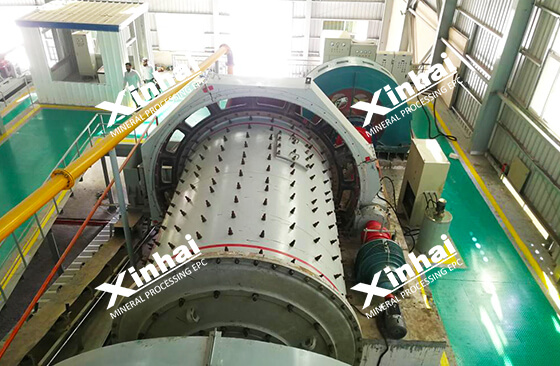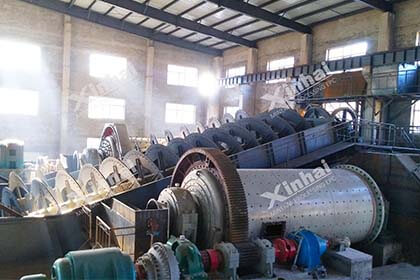The Gold Ball Mill: A Crucial Tool in Gold Ore Processing
 Shirley
Shirley
 Dec 04, 2024
Dec 04, 2024
 2354
2354
If you want to know more details about equipment, solutions, etc, please click the button below for free consultation, or leave your requirements!

In the world of mining and metallurgy, the gold ball mill stands as a testament to human ingenuity and technological advancement. This robust piece of machinery plays a pivotal role in the extraction and processing of gold, a precious metal that has captivated humanity for centuries. In this article, we will delve into the world of gold ball mills, exploring their working principles, applications, advantages, and the future of this essential tool in the gold mining industry.
01What is a Gold Ball Mill?
BackA gold ball mill is a type of grinding mill used in the mining industry to crush and grind gold ore into finer particles. It is an essential component of the gold extraction process, as it helps to liberate gold from the surrounding rock matrix, making it easier to extract using various methods such as cyanidation, amalgamation, or gravity separation.
The gold ball mill is a cylindrical device filled with steel balls or other grinding media. As the mill rotates, the grinding media is lifted and then cascades down, crushing and grinding the ore into smaller particles. The size of the grinding media and the rotation speed of the mill are carefully controlled to achieve the desired particle size.
02The Working Principle of a Gold Ball Mill
BackThe operation of a gold ball mill is based on the principles of mechanical attrition and impact. The mill is typically lined with wear-resistant materials such as rubber or manganese steel to withstand the harsh conditions inside. As the mill rotates, the grinding media is lifted by the rising side of the mill and then cascades down, creating a cascading effect that grinds the ore.
The ore is fed into the mill through a hopper, and water or a grinding medium is added to create a slurry. The slurry is then pumped into the mill, where it is subjected to intense grinding action. The size of the particles is reduced progressively as they are crushed and ground by the steel balls.
The gold ball mill is designed to achieve a specific particle size distribution, which is crucial for the subsequent steps in the gold extraction process. The finer the particles, the more surface area is exposed, making it easier to leach the gold using chemical processes.

03Types of Gold Ball Mills
BackThere are several types of gold ball mills, each designed for specific applications and operating conditions. The most common types include:
Overflow Type Gold Ball Mill: This is the most widely used type of ball mill in the gold mining industry. It is designed to handle a wide range of feed sizes and can achieve a fine grind size. The overflow type mill allows the slurry to overflow continuously, ensuring a consistent particle size distribution.
Grate Type Gold Ball Mill: The grate type mill is designed for coarse grinding applications. It features a grate discharge system that prevents the larger particles from escaping, ensuring that only the fine particles are discharged. This type of mill is commonly used in the primary grinding stage of gold ore processing.
Lattice Type Gold Ball Mill: The lattice type mill is similar to the grate type mill but features a lattice-type discharge system. It is designed for applications where a higher capacity and finer grind size are required. The lattice type mill is often used in the secondary grinding stage of gold ore processing.

04Advantages of Using a Gold Ball Mill
BackThe gold ball mill offers several advantages over other grinding methods, making it the preferred choice in the gold mining industry:
High Efficiency: The gold ball mill is capable of achieving a high grinding efficiency, even for hard and abrasive ores. Its robust design and durable components ensure reliable performance under demanding conditions.
Wide Application Range: The gold ball mill can be used for a wide range of ores, including gold, silver, copper, and other precious metals. Its versatility makes it a valuable asset in various mining operations.
Adjustable Fineness: The gold ball mill allows for precise control over the particle size distribution, enabling operators to achieve the desired fineness for optimal gold extraction.
Durable and Long-Lasting: The gold ball mill is built to withstand the harsh conditions of mining operations, with wear-resistant components and a sturdy design. This ensures a long service life and minimal maintenance requirements.
05Factors to Consider When Choosing a Gold Ball Mill
BackSelecting the right gold ball mill for your operation is crucial for achieving optimal performance and efficiency. Several factors should be considered when choosing a gold ball mill:
Ore Characteristics: The hardness, abrasiveness, and moisture content of the ore will influence the choice of mill. Harder ores may require a more robust mill with larger grinding media, while softer ores may be processed with a smaller mill.
Required Fineness: The desired particle size distribution will determine the type and size of the mill. Fine grinding requires a mill with a smaller diameter and higher rotation speed, while coarse grinding can be achieved with a larger mill and slower rotation.
Capacity: The capacity of the mill should match the production requirements of the operation. Overloading the mill can lead to reduced efficiency and increased wear on the components.
Energy Consumption: The energy consumption of the mill is an important consideration, as it directly impacts the operating costs of the operation. More efficient mills with lower energy consumption can result in significant cost savings over time.
06Maintenance and Care of a Gold Ball Mill
BackTo ensure the optimal performance and longevity of a gold ball mill, regular maintenance and care are essential. Some key maintenance practices include:
Regular Inspection: Regular inspection of the mill's components, including the grinding media, liners, and discharge system, is crucial for identifying potential issues before they lead to equipment failure.
Lubrication: Proper lubrication of the mill's bearings and other moving parts is essential for reducing wear and tear and extending the service life of the equipment.
Replacement of Worn Parts: Worn or damaged components, such as liners and grinding media, should be replaced promptly to prevent further damage and ensure efficient operation.
Cleaning: Regular cleaning of the mill and its components is necessary to prevent the buildup of ore dust and debris, which can affect the mill's performance.
07The Future of Gold Ball Mills
BackAs the gold mining industry continues to evolve, so too does the technology behind gold ball mills. Advancements in materials science, automation, and energy efficiency are driving the development of more efficient and sustainable gold ball mills.
One area of innovation is the use of advanced materials for the mill's components, such as high-chromium steel liners and ceramic grinding media. These materials offer improved wear resistance and longer service life, reducing maintenance costs and extending the mill's operational lifespan.
Another area of focus is the integration of automation and digital technology into gold ball mill operations. Advanced control systems and sensors can optimize the mill's performance, monitor key parameters in real-time, and predict potential issues before they occur. This leads to improved efficiency, reduced downtime, and lower operating costs.

08Conclusion
BackThe gold ball mill is an indispensable tool in the gold mining industry, playing a critical role in the extraction and processing of gold ore. Its versatility, efficiency, and durability make it the preferred choice for grinding gold ore to the desired fineness. As technology continues to advance, we can expect to see even more innovative developments in gold ball mill design and operation, further enhancing their performance and contribution to the gold mining industry.
For mining operations looking to optimize their gold extraction processes, investing in a high-quality gold ball mill is a wise decision. By considering the factors outlined in this article and adhering to proper maintenance practices, operators can ensure the reliable and efficient performance of their gold ball mills, ultimately leading to higher gold recovery rates and greater profitability.
 +86 18234403483
+86 18234403483 yanzhang19990421@gmail.com
yanzhang19990421@gmail.com




 Message
Message Chat Now
Chat Now


















